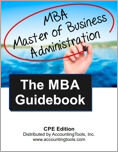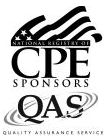The MBA Guidebook (CPE Course)
CPE Credit: 23 hours
Course Type: Downloaded PDF materials with online test
Price (with PDF Textbook): $160
Course Description
It takes several years and a substantial amount of money to complete a formal MBA program, where students wade through many theoretical concepts that are never used in the real world. There is a quicker and more effective way to learn the practical side of business management. The MBA Guidebook describes the essentials of the core topics covered in a top-tier MBA program. The intent is to give the user a broad understanding of the most essential concepts needed to run a business – in one comprehensive course. Topics covered include sales and marketing, operations management, product development, risk management, business valuation, capital structure analysis, and the interpretation of financial statements. In short, The MBA Guidebook provides the essential knowledge for operating a successful business.
Author: Steven Bragg
Course Number: BM1002
Table of Contents
Chapter 1. Accounting Basics
Chapter 2. The Financial Statements
Chapter 3. The Interpretation of Financial Statements
Chapter 4. The Cost of Capital
Chapter 5. Discounted Cash Flow Techniques
Chapter 6. Business Investment Decisions
Chapter 7. Capital Structure Analysis
Chapter 8. Mergers & Acquisitions
Chapter 9. Business Valuation
Chapter 10. Enterprise Risk Management
Chapter 11. Product Development
Chapter 12. Marketing
Chapter 13. Sales
Chapter 14. Operations Management
Chapter 15. Supply Chain Management
Chapter 16. Recruiting and Hiring
Chapter 17. Building and Managing Teams
Chapter 18. Business Ethics
Chapter 19. Business Strategy
Chapter 20. Managerial Economics
Learning Objectives
Recognize the different types of accounting principles, and the nature of the realization concept.
Cite the stages in the accounting cycle.
Specify the activities that are part of the financing, purchasing, payroll, and sales cycles.
Specify the requirements of the accrual method of accounting.
Identify the uses of each of the financial statements.
Specify the sources of retained earnings.
Recognize how the different ratios and other analyses are used to interpret financial statements.
Recognize the contents of the cost of capital, and how it is calculated.
Identify the reason why preferred stock is more expensive than debt.
Specify the circumstances under which different debt values can be used in the cost of capital.
Specify the basis for the use of discounted cash flow analysis.
Recognize the concept of an annuity.
Cite the uses for net present value analysis, the internal rate of return, the payback method, and real options.
Specify the ranking of criteria used to evaluate investment proposals.
Recognize the rules for investing in a complex environment.
Identify the concerns with using the accounting rate of return.
Recognize why financial leverage can be so beneficial, as well as its dangers for a business.
Specify the reasons why managers are more likely to use financial leverage.
Identify the triggering events for a capital structure analysis.
Recognize the effects of a tax shield, and how it works.
Specify the different types of loan covenants.
Cite the different types of strategies that can justify an acquisition.
Identify the sources of financial information about publicly-held businesses.
Recognize the different documents used in the purchase and sale of businesses.
Specify the motivations of a financial buyer.
Recognize the different methods used to value a business, and how each one can be adjusted.
Identify the effects of consistent earnings on a firm’s stock price.
Cite the characteristics of businesses that can retain risk.
Identify the characteristics of an enterprise risk management system.
Identify the types of information included in a risk profile.
Specify the steps involved to build a product within a target costing program.
Recognize the uses to which the R&D waste measurement can be put.
Identify the actions that can be taken to manage inventory levels.
Recognize the different types of pricing strategies.
Specify the risks associated with marketing, and how they can be mitigated.
Recognize the calculation for lifetime value.
Identify the methods used to aggregate information into a revenue budget, and the issues with an excessively detailed level of reporting.
Recognize the risks associated with sales, and how they can be mitigated.
Specify the basic concepts that underlie constraint analysis, as well as the calculation of throughput.
Cite the circumstances under which a product can be justifiably cancelled.
Identify how a business can achieve a high quality of design.
Recognize the different types of quality costs.
Specify the components that comprise a material requirements planning system.
Cite the methods used to achieve short production runs.
Identify the items to review as part of a supplier assessment.
Recognize the issues to be addressed when considering a foreign supplier.
Specify the advantages of a stable production schedule.
Cite the tools available for bulk hiring.
Identify the methods used to examine a resume.
Recognize the purposes of telephone screening.
Specify the impact of the cloning effect on the hiring process.
Cite the essential components of a team.
Rank the different levels of communication methods within a team.
Recognize the effects of the stakeholder perspective on ethical decisions.
Specify the reasons why people tend to overlook ethical issues.
Identify the steps used in the development of a strategy.
Specify the characteristics of opportunity costs and implicit costs.
State the situations in which price ceilings and price floors are imposed.
Recognize the situations in which marginal analysis is used.
Identify demand shifters and supplier shifters, and their impacts.
Specify the situations in which demand can be elastic or inelastic.
Identify the situations in which economies of scope can be employed.
Level: Overview
Instructional Method: QAS Self-Study
NASBA Category: Business Management & Organization
Prerequisites: None
Advance Preparation: None
Latest Review Date: March 2025
Program Registration Requirements: Click on "Purchase Course" near the top of this page to pay for and access the course. You will then be able to download the course as a PDF file, then take an on-line examination, and then download a certificate of completion if you pass the examination.
Program Refund Policy: For more information regarding administrative policies concerning complaints, refunds, and other matters, see our policies page.
AccountingTools, Inc. is registered with the National Association of State Boards of Accountancy (NASBA) as a sponsor of continuing professional education on the National Registry of CPE Sponsors. State boards of accountancy have the final authority on the acceptance of individual courses for CPE credit. Complaints regarding registered sponsors may be submitted to the National Registry of CPE Sponsors through its website: www.nasbaregistry.org.
The NASBA sponsor identification number for Accountingtools, Inc. is 115881.
AccountingTools is an IRS Approved Continuing Education Provider. We are compliant with the requirements for continuing education providers (as described in sections 10.6 and 10.9 of the Department of Treasury’s Circular No. 230 and in other IRS guidance, forms, and instructions). Our IRS Approved Continuing Education Provider number is 72821.


